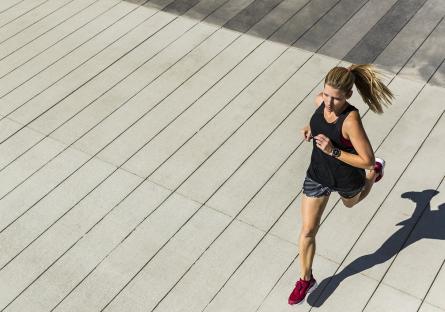This article appears for archival purposes. Any events, programs and/or initiatives mentioned may no longer be applicable.

As the weather starts to warm up, the time is right to lace up your sneakers and hit the ground running. Running can be a great form of exercise, partly because the barrier for entry is so low. You don’t need a gym membership or have to spend hours watching YouTube videos on form to get up to speed—all you need is a good, supportive pair of athletic shoes and enough open space to get a good sweat going. With Rio Salado’s 6th annual Dash With Splash run coming up on April 6, there’s no better time to learn about the many physical and mental health benefits of running.
Improves Cardiovascular Health
Running for at least 10 minutes 3-4 days a week can level up your cardio. Running can lower your risk of developing cardiovascular and heart disease. One of the key benefits of running is that it lowers your resting heart rate. The lower your beats per minute at rest, the more efficient it is. That number is a great overall indicator for your health. The actual range for what a good resting heart rate is varies by age and body type, but the average is 60-100.
Boosts Longevity
An added benefit of the cardiovascular-boosting effect running has on the body is that it can help you live longer. Studies have found that runners have 45 percent reduced risk of death from heart attacks and strokes. Research has also found a link between running and a reduced risk of developing cancer and neurologic diseases such as Alzheimer's and Parkinson's. No one outruns the Reaper but taking up a running regimen could give you a nice head start.
Brightens Mood
Adults who get at least 2.5 hours of moderate physical activity per week tend to be at a lower risk for depression compared to people who don’t exercise. A study to compare the effects of running versus taking antidepressants to alleviate depression found that the two activities have a similar success rate. Running also takes the pressure off your stress levels by releasing endorphins that reduce your cortisol levels. Cortisol is also known as the stress hormone, so any activity that helps cut it down to size is worth the effort.
Eases Back Pain & Strengthens Knees
One of the most surprising benefits of running is that it can actually be good for your knees! Running is a high impact exercise, so a very common concern is that it can hurt your knees or back over time. Studies have found the opposite to be true: seasoned runners report less back and knee pain and lower instances of arthritis than non-runners of similar age and build.
Better Sleep Quality
Like most forms of exercise, your run-time can do wonders for your bedtime. Running can improve your quality of sleep by reducing stress, releasing relaxing endorphins, and tiring yourself out to make it easier to slip into a homeostatic state for resting.
Runner’s High
Anyone who runs long enough is probably familiar with the “runner’s high.” This is a rare state of euphoria induced by intense exercise. A perk of running is that you may eventually experience this brief, rapturous feeling. How the “high” works is that your body releases a cocktail of hormones as you exercise. The endorphins in your body help keep your muscles from feeling pain. The dopamine release that comes from regular exercise gives you a pleasant, rewarding sensation: the joy of a job well-done. But the real secret ingredient of the runner’s high is that exercise increases the levels of endocannabinoids in your bloodstream. These neurotransmitters induce a feeling of relaxation that’s similar to cannabis but produced naturally by the body itself. Researchers think it’s this increase in endocannabinoid activity that creates that transcendent feeling people experience during a runner’s high.
Check In Before You Step Out
As always with any rigorous exercise plan, you should consult with a doctor ahead of time to make sure that running is a safe and healthy activity for you. Be sure to invest in proper shoes (you don’t need fancy running shoes to run but a good sturdy pair of trainers go a long way) and vary the hardness of the surfaces you run on. Running on concrete will impact you differently than running on dirt or a spongy forest floor. Keep in mind that “soft” surfaces aren’t necessarily safer for you because they can be uneven and slippery. If you don’t already have one, getting a pedometer to track your step count and monitor heart rate is also a good investment.
Article by Austin Brietta
Want more wellness tips? Check out these stories: